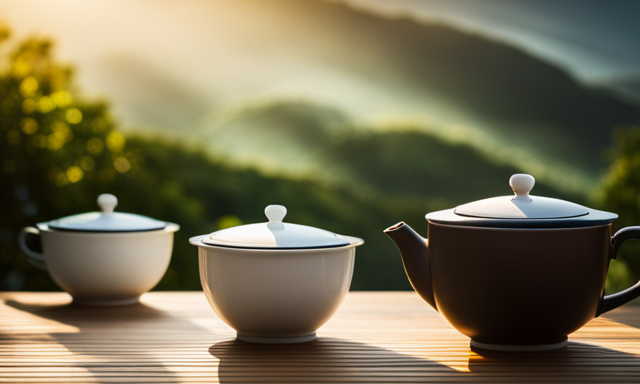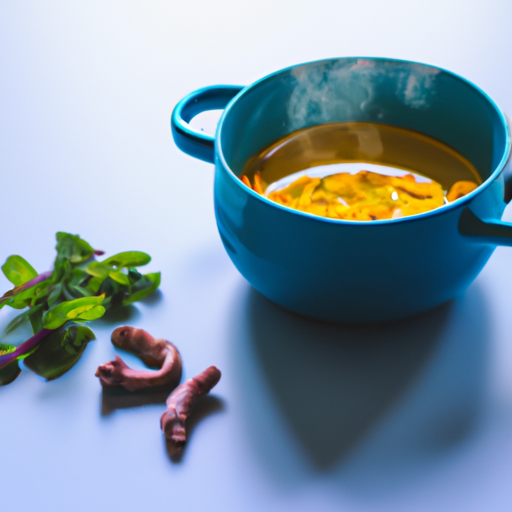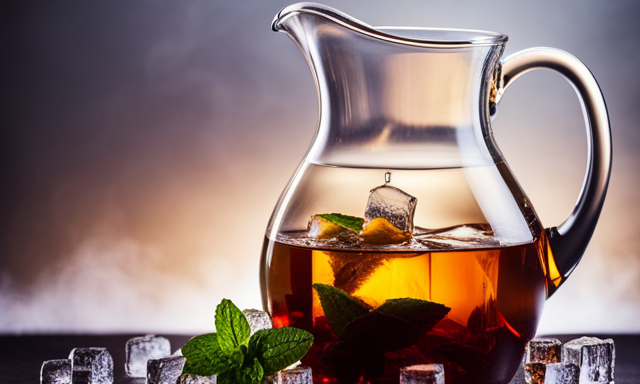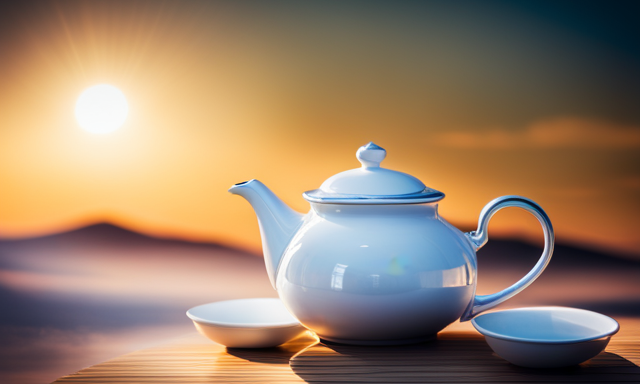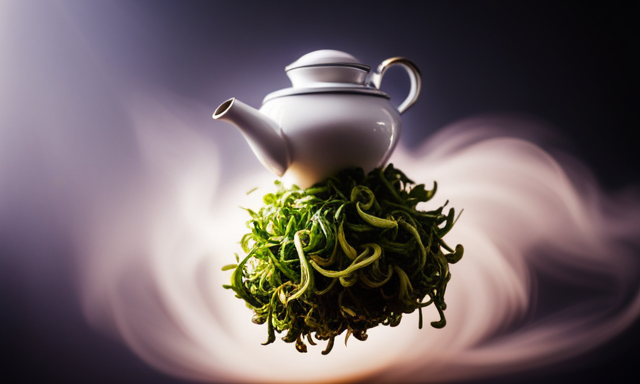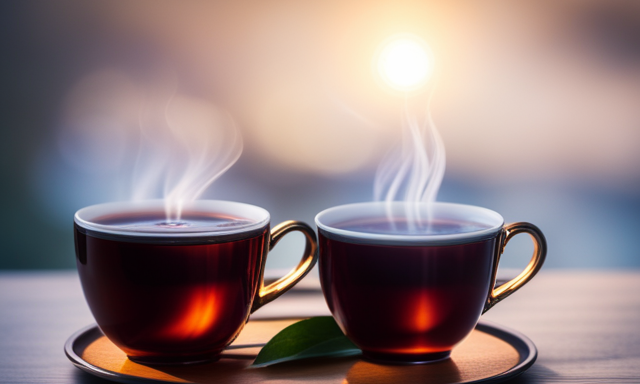When it comes to tea, there’s nothing quite like brewing a fresh cup that transports you to a world of tranquility and comfort. As a tea enthusiast, I’ve discovered that white, green, and oolong teas offer a delightful array of flavors and aromas that cater to every palate. Each variety has its own unique characteristics, making the world of tea a fascinating journey to embark on.
In this article, we will delve into the captivating world of white, green, and oolong teas, exploring their origins, brewing techniques, and the intricate nuances that set them apart.
From the delicate and subtle notes of white tea to the vibrant and grassy flavors of green tea, and the rich and complex profiles of oolong tea, we will uncover the secrets to brewing the perfect cup of each.
So, grab your favorite teapot and join me as we embark on a voyage of tea appreciation, uncovering the wonders of these exquisite teas and discovering how to brew them to perfection.
Key Takeaways
- Oolong tea has a unique flavor and aroma and is rich in antioxidants.
- Oolong tea should be brewed at a lower temperature than black tea.
- Oolong tea has floral, fruity, and nutty undertones and can be paired with light desserts, seafood, and grilled vegetables.
- To preserve the freshness of tea, it should be stored in airtight containers away from light, heat, and strong-smelling substances.
Introduction to White Tea
White tea is a heavenly beverage with delicate flavors and subtle aromas. It not only offers a delightful taste but also provides numerous health benefits. Packed with antioxidants, white tea helps boost your immune system, promotes healthy skin, and aids in weight loss.
Brewing white tea requires a gentle touch to preserve its delicate flavor. Unlike other teas, it is best steeped in water that is slightly below boiling point, around 175°F. Allow the tea leaves to steep for about 2-3 minutes to achieve the perfect balance of flavor.
The subsequent section will delve into the precise steps of brewing white tea, ensuring you savor every sip of this exquisite beverage.
How to Brew White Tea
When it comes to brewing white tea, there are two key factors to consider: water temperature and steeping time.
White tea is delicate, so it’s important to use a lower water temperature. Aim for around 175°F (80°C) to prevent the tea from becoming bitter.
The steeping time for white tea generally falls between 2 to 4 minutes. However, the exact duration can vary depending on personal preference for strength. Adjust the steeping time to suit your taste.
To ensure proper extraction and enjoyment of the delicate flavors of white tea, it’s crucial to choose the right teapot and infuser.
For brewing white tea, a ceramic or glass teapot with a stainless steel infuser is ideal. This combination allows for a controlled and even distribution of heat, which is essential for brewing white tea properly.
Remember to follow these guidelines when brewing white tea to achieve the best flavor and avoid any bitterness.
Water Temperature and Steeping Time
As the water temperature rises and the tea leaves steep, the flavors and aromas begin to infuse, creating a delightful beverage. To ensure the perfect cup of white tea, it is essential to pay attention to the water temperature and steeping techniques. Here are three key factors to consider:
-
Water Temperature: White tea is delicate and requires a lower water temperature compared to other teas. Aim for a temperature between 160°F and 180°F (71°C and 82°C) to avoid scorching the leaves and preserve the subtle flavors.
-
Steeping Time: White tea should be steeped for a shorter duration compared to other teas. A general guideline is to steep white tea for 2-3 minutes. Adjust the steeping time based on personal preference to achieve the desired strength.
-
Patience: Allow the tea leaves ample time to unfurl and release their flavors. Rushing the steeping process may result in a weaker and less flavorful cup of tea.
Now that we have mastered water temperature and steeping techniques, let’s move on to choosing the right teapot and infuser for a truly enjoyable tea experience.
Choosing the Right Teapot and Infuser
To enhance your tea-drinking experience, selecting the perfect teapot and infuser is crucial. When it comes to choosing the right teapot, there are a few factors to consider.
First, consider the material of the teapot. Porcelain and ceramic teapots are excellent choices for brewing white, green, or oolong tea as they retain heat well and do not affect the flavor of the tea.
Second, pay attention to the size of the teapot. It should be large enough to accommodate the amount of tea you want to brew, but not too large that the tea becomes diluted.
As for the infuser, opt for a fine mesh stainless steel one to prevent any tea leaves from escaping into your cup.
Tea brewing techniques rely on a proper steeping process, and having the right teapot and infuser plays a crucial role in achieving that perfect cup of tea.
Now that we have covered the importance of choosing the right teapot and infuser, let’s move on to the next step: an introduction to green tea.
Introduction to Green Tea
Green tea is a fascinating and diverse beverage that offers a wide range of flavors and health benefits.
There are numerous varieties of green tea, such as sencha, matcha, and genmaicha, each with its own unique characteristics and brewing methods.
Not only is green tea delicious to drink, but it also contains antioxidants that can help promote overall health and well-being.
Varieties of Green Tea
Imagine yourself sipping on a refreshing cup of green tea, feeling like a zen master in a Japanese tea ceremony. Green tea comes in various types, each with its own unique flavor profile and characteristics. Here are three popular varieties of green tea that you should try:
-
Matcha: This vibrant, powdered green tea is made by finely grinding shade-grown tea leaves. It is known for its intense flavor and high concentration of antioxidants.
-
Sencha: The most commonly consumed green tea in Japan, sencha has a delicate and grassy taste. It is rich in catechins, which are natural antioxidants that help promote overall health.
-
Gunpowder: Originating from China, gunpowder tea is named after its tightly rolled leaves. It has a smoky and slightly bitter taste, making it a favorite choice for those who prefer stronger flavors.
Drinking green tea offers numerous health benefits, including improved brain function and a lower risk of certain diseases. Transitioning into the subsequent section about health benefits and antioxidants, let’s explore how green tea can boost your overall well-being.
Health Benefits and Antioxidants
Now that we’ve explored the different varieties of green tea, let’s delve into the health benefits and antioxidants it contains.
Green tea is well-known for its high concentration of antioxidants, which can help combat the effects of aging on the body. These antioxidants, such as catechins and flavonoids, work to neutralize harmful free radicals and protect our cells from damage.
Additionally, research suggests that regularly consuming green tea may contribute to weight loss by boosting metabolism and aiding in fat oxidation. Not only does green tea offer potential weight loss benefits, but it also supports overall health and well-being.
With its numerous health benefits and powerful antioxidants, it’s no wonder green tea has gained popularity worldwide.
Now, let’s move on to the next section and learn how to brew green tea effectively.
How to Brew Green Tea
First, steep the green tea leaves in hot water for a few minutes to release their vibrant flavors and delicate aromas. Green tea is known for its health benefits and is packed with antioxidants. To brew green tea, it is important to use the right techniques and tea brewing accessories. Here is a table outlining the brewing process for green tea:
| Step | Time | Water Temperature |
|---|---|---|
| Preheat teapot or cup | N/A | 176°F |
| Measure tea leaves | 1 tsp per cup | N/A |
| Rinse the tea leaves | 10 seconds | N/A |
| First infusion | 1 minute | 176°F |
| Second infusion | 30 seconds | 176°F |
By following these steps, you can enjoy a perfectly brewed cup of green tea. In the next section, we will discuss an introduction to oolong tea.
Introduction to Oolong Tea
Oolong tea has been enjoyed for centuries and is known for its unique flavor profiles, ranging from floral and fruity to toasty and nutty. Did you know that oolong tea is often referred to as the ‘champagne of teas’ due to its complex and refined taste?
Originating from China, oolong tea is partially oxidized, making it fall between the categories of green and black tea. This unique process gives oolong tea its distinct flavor and aroma.
Besides its delightful taste, oolong tea also offers numerous health benefits. It is rich in antioxidants, which help protect the body against free radicals and reduce the risk of chronic diseases. Oolong tea also contains catechins and polyphenols that promote heart health and boost metabolism.
Transitioning into how to brew oolong tea, let’s delve into the art of preparing this exquisite beverage.
How to Brew Oolong Tea
Get ready to experience the perfect cup of oolong tea by following these simple steps.
Brewing oolong tea requires specific techniques to bring out its unique flavors and aromas. Start by heating water to around 180°F, as oolong tea is best brewed at a lower temperature than black tea.
Measure one teaspoon of oolong tea leaves for every 8 ounces of water and place them in a teapot or infuser. Pour the hot water over the leaves and let it steep for 3-5 minutes, depending on your desired strength. The color of the tea should be a rich golden hue.
Once the steeping time is up, strain the tea and pour it into your cup.
Now, let’s move on to the next section to explore the fascinating tasting notes and flavor profiles of oolong tea.
Tasting Notes and Flavor Profiles
Indulge your senses with the delightful flavors and aromas of oolong tea, which has been enjoyed by tea enthusiasts for centuries and is known to have a wide range of tasting notes, including floral, fruity, and even nutty undertones. Did you know that oolong tea is believed to have originated in China and accounts for only 2% of the world’s tea production?
When it comes to experiencing the full spectrum of oolong tea’s flavors, there are a few tasting techniques you can employ. Start by taking small sips and allowing the tea to coat your palate. Pay attention to the different layers of flavor that unfold, from the initial sweet or floral notes to the lingering aftertaste. You can also try slurping the tea, which helps aerate and enhance the flavors.
To complement the unique characteristics of oolong tea, consider tea pairing suggestions such as light desserts like fruit tarts or almond cookies. The floral and fruity undertones of oolong tea can also be a great accompaniment to seafood or grilled vegetables.
Transitioning to the next section about storing and preserving tea, it is essential to understand the importance of proper storage techniques to maintain the freshness and flavor of your oolong tea.
Storing and Preserving Tea
After exploring the various tasting notes and flavor profiles of white, green, and oolong tea, it is important to understand how to properly store and preserve these teas to maintain their freshness. Storing tea correctly is crucial in order to maximize its shelf life and preserve its delicate flavors. There are several techniques that can help in this process.
- Keep tea away from light and heat to prevent oxidation and loss of flavor.
- Store tea in airtight containers to protect it from moisture and odors.
- Avoid storing tea near strong-smelling substances, as tea easily absorbs odors.
- Consider using opaque containers to block out light and maintain tea’s freshness.
- Keep different types of tea separate to prevent cross-contamination of flavors.
By following these storing techniques, you can ensure that your tea stays fresh and flavorful for a longer period of time.
Now, let’s explore the fascinating world of tea etiquette and traditions.
Tea Etiquette and Traditions
Experience the elegance and charm of tea etiquette and traditions as we delve into the fascinating customs that have been passed down through generations.
Tea ceremonies and rituals are an integral part of tea culture, particularly in countries like China and Japan. These ceremonies are steeped in symbolism and are a way to celebrate the art of tea preparation and consumption. From the precise movements of the tea ceremony to the careful selection of tea utensils, every detail is thoughtfully considered.
Tea etiquette varies across cultures, but the common thread is the respect and appreciation for tea as a sacred beverage. Understanding and honoring these traditions can enhance the overall tea-drinking experience.
Now, let’s move on to exploring tea blends and infusions, where we can discover new flavors and aromas to delight our senses.
Exploring Tea Blends and Infusions
Discover the exquisite flavors and captivating aromas that await you as you embark on a journey of exploring the intricate world of tea blends and infusions. Tea blending techniques allow for endless possibilities, as different teas and herbs can be combined to create unique and delicious flavors.
Here are three sub-lists to guide you in your exploration:
-
Herbal Infusions:
- Chamomile: Known for its calming properties, chamomile infusions can help promote relaxation and better sleep.
- Peppermint: Refreshing and invigorating, peppermint infusions can aid digestion and provide relief from headaches.
- Hibiscus: Vibrant and tart, hibiscus infusions are rich in antioxidants and can support heart health.
-
Black Tea Blends:
- Earl Grey: Combining black tea with bergamot oil, Earl Grey offers a bold and citrusy flavor.
- Masala Chai: A blend of black tea and spices like cinnamon and cardamom, Masala Chai is warm and spicy.
- English Breakfast: A classic blend of black teas, English Breakfast is robust and full-bodied.
-
Green Tea Blends:
- Jasmine Green Tea: Fragrant and delicate, jasmine green tea is infused with jasmine flowers, lending a floral aroma.
- Matcha: Made from powdered green tea leaves, matcha offers a vibrant green color and a rich, umami flavor.
- Sencha: A popular Japanese green tea, sencha has a grassy and slightly sweet taste.
Incorporating tea blending techniques allows you to create personalized flavors while reaping the benefits of herbal infusions. Whether you’re seeking relaxation, digestion support, or a burst of flavor, exploring tea blends and infusions opens up a world of possibilities. Start experimenting and enjoy the delightful experience of crafting your own unique tea blends.
Frequently Asked Questions
Is it possible to mix different types of tea together to create a unique blend?
Yes, it is possible to mix different types of tea together to create unique tea blends. By experimenting with tea flavors, you can discover exciting combinations that cater to your personal taste preferences.
Can I use the same brewing method for all types of tea?
Different types of tea cannot be brewed using the same method. Each type requires specific water temperatures for optimal flavor. For example, white tea is brewed at a lower temperature than green or oolong tea.
What is the ideal water temperature for brewing white, green, and oolong tea?
The ideal water temperature for brewing white, green, and oolong tea varies. White tea is best brewed with water around 175°F, green tea at 160-180°F, and oolong tea at 180-190°F. These temperatures ensure optimal flavor extraction and prevent bitterness.
Are there any health benefits associated with drinking white, green, or oolong tea?
There are numerous health benefits associated with drinking white, green, and oolong tea. Each type has its own unique advantages, such as boosting metabolism, improving heart health, and aiding in weight loss. To fully enjoy these benefits, it’s important to brew each tea correctly.
How long can I store white, green, or oolong tea before it loses its freshness?
Tea is like a delicate flower, its freshness blossoms but fades over time. To savor the vibrant taste, store white, green, or oolong tea properly. Depending on the type, it can last from 6 months to 2 years, preserving its invigorating essence.
Conclusion
In conclusion, white, green, and oolong teas each offer unique flavors and health benefits that can be enjoyed through proper brewing techniques.
As a tea enthusiast, I have learned that approximately 80% of tea consumed worldwide is black tea, while white, green, and oolong teas make up the remaining 20%. This statistic paints a vivid picture of the vast variety and popularity of tea around the globe.
Whether you prefer the delicate notes of white tea, the grassy freshness of green tea, or the rich complexity of oolong tea, there is a tea out there to suit every taste.
So, grab your favorite tea leaves, brew them to perfection, and enjoy the wonderful world of tea.

